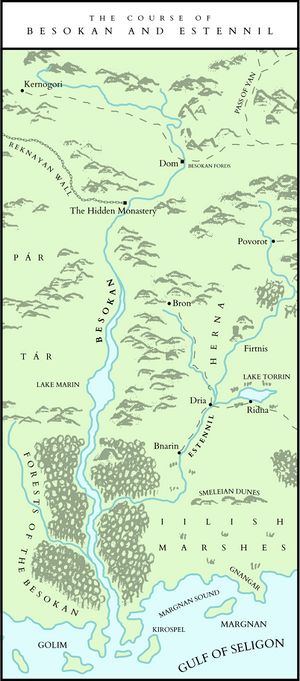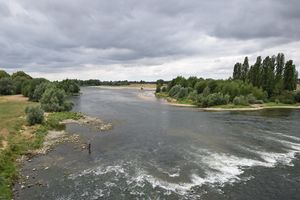Difference between revisions of "Besokan river"
| Line 1: | Line 1: | ||
[[File:The Course of Besokan and Estennil.jpg|50%|thumb|alt=A map showing the course of the Besokan river, as described in this article, and its major tributary, the Estennil river.|The Course of Besokan and Estennil]] | |||
The '''Besokan''' is a major river of the eastern [[Reknaya]] and the traditional dividing line between [[Belkondíl]] and [[Old Seligon]]. With a maximal width of over 300 [[Olgish system of measurement|elôrini]], it is considered [[Elondor]]’s widest river. | The '''Besokan''' is a major river of the eastern [[Reknaya]] and the traditional dividing line between [[Belkondíl]] and [[Old Seligon]]. With a maximal width of over 300 [[Olgish system of measurement|elôrini]], it is considered [[Elondor]]’s widest river. | ||
==Etymology and Names== | ==Etymology and Names== | ||
The name ''Besokan'' is of [[Olgish language|Olgish]] origin, most likely related to ''Besok'', an ethnonym for to the inhabitants of the Besokan Valley and possibly the lands to its west (largely [[Soskish peoples|Soskish]] and [[Reknayans (ethnicity)|Reknayan]] populations). The term means ‘gift people’ or ‘fee people’, referring either to valuable gifts brought to Belkdondíl by Soskish merchants or to their function as merceraries, notably as hired cavalrists, in the [[Olgish peoples|Olgish]] kingdoms. The ending ''-an'' is a commonly found Olgish nominalizer, or could be a related to the root ''*an-'' ‘to proceed, progress’, referring either to the river itself or demarking the area the Besok came from. The term is found denoting the border, or possibly a country, between Belkondíl and (Old) Seligon in the [[Lonsorigi|earlier Olgish writings]] (c. 700 B.E.B.) and by the end [[Olgish Expansion]] had been established as the general name for the river. | The name ''Besokan'' is of [[Olgish language|Olgish]] origin, most likely related to ''Besok'', an ethnonym for to the inhabitants of the Besokan Valley and possibly the lands to its west (largely [[Soskish peoples|Soskish]] and [[Reknayans (ethnicity)|Reknayan]] populations). The term means ‘gift people’ or ‘fee people’, referring either to valuable gifts brought to Belkdondíl by Soskish merchants or to their function as merceraries, notably as hired cavalrists, in the [[Olgish peoples|Olgish]] kingdoms. The ending ''-an'' is a commonly found Olgish nominalizer, or could be a related to the root ''*an-'' ‘to proceed, progress’, referring either to the river itself or demarking the area the Besok came from. The term is found denoting the border, or possibly a country, between Belkondíl and (Old) Seligon in the [[Lonsorigi|earlier Olgish writings]] (c. 700 B.E.B.) and by the end [[Olgish Expansion]] had been established as the general name for the river. | ||
Revision as of 09:27, 14 April 2023
The Besokan is a major river of the eastern Reknaya and the traditional dividing line between Belkondíl and Old Seligon. With a maximal width of over 300 elôrini, it is considered Elondor’s widest river.
Etymology and Names
The name Besokan is of Olgish origin, most likely related to Besok, an ethnonym for to the inhabitants of the Besokan Valley and possibly the lands to its west (largely Soskish and Reknayan populations). The term means ‘gift people’ or ‘fee people’, referring either to valuable gifts brought to Belkdondíl by Soskish merchants or to their function as merceraries, notably as hired cavalrists, in the Olgish kingdoms. The ending -an is a commonly found Olgish nominalizer, or could be a related to the root *an- ‘to proceed, progress’, referring either to the river itself or demarking the area the Besok came from. The term is found denoting the border, or possibly a country, between Belkondíl and (Old) Seligon in the earlier Olgish writings (c. 700 B.E.B.) and by the end Olgish Expansion had been established as the general name for the river.
The Old Besokian World Map lists it as Kô-Nôwis, from a possible Proto-Besokian *Kô-Nôwisten ‘Great Mother’ (hence Soskish Kônovec), thought to refer to the river’ significance to early Besokian culture. The Besokian languages were in turn named after the Besokan.
Course and Hydrology
The source of the Besokan is located in the Erkenmian Mountains north of Kernogori. It has no major tributary on its course through the Dark Valley but is said to be ‘fed by a thousand streams’ as it passes through the fertile landscape, and reaching Dom the river has already grown to a major body of water. From there, it turns south, passing the southeastern end of the Reknayan Wall and entering a narrower valley, the Besokan Valley proper, between the Herna mountains and the Párian Ridge. For most of its upper course, passing large beds of gravel and sand, and despite its renowned width, the Besokan does not achieve a great depth, remaining relatively shallow until it enters the plain of Tár. The river proceeds in a trough close to the Herna mountains, again fed by countless small streams and growing in sizeuntil it forms Lake Marin immediately north of the gorge of the same name, the southern entrance of Tár. Exiting the gorge and passing Nishûnâc, the remainder of its course is hemmed by rolling hills and dense woodland, the Forests of the Besokan. It is here that the Besokan meets its major tributary, the Estennil river. The combined bodies of water reach a maximal width of 317 elôrini, the widest of any river in Elondor. They mouth into the Gulf of Seligon forming a bar-built estuary between the islands of Golim and Kirospel.
Cultural Significance
The lower Besokan Valley was the original homeland of the Besokian peoples, who referred to it as ‘Great Mother’, equating it with their main goddess (a figure comparable to both the goddess Ílgar and the titan Kána in Olgish mythology). Much of the early Besokain cult at Nish

